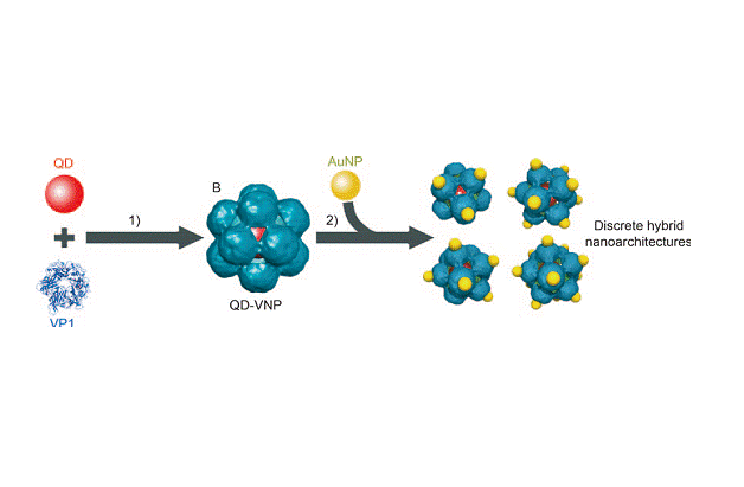Discrete nanoparticle (NP) ensembles have attracted increasing attention because of their potentials in fundamental researches and novel functional devices. For example, discrete gold and silver NP dimers displayed strong plasmon coupling and functioned as a molecular ruler. In order to tailor the component and conformation of such structures, different strategies employing small molecules, peptides and DNA have been explored to guide the assembly of NPs. However, they are restricted to organizing NPs into one-dimensional (1D) and 2D nanostructures. A robust platform for controlling 3D NP assembling with finer tunability still remains a challenge.
Recently, Prof. WANG Qiangbin group at the Suzhou Institute of Nano-tech & Nano-bionics (SINANO), CAS in collaboration with the Nanobiology Lab at Wuhan Institute of Virology, has developed a virus-based nanoparticle (VNP) guided strategy for controllable assembly of 3D nanoarchitectures. By rationally engineering the functionality of VNPs and simply tuning the ratio of the two kind of integrated NPs, discrete ensembles with a quantum dot (QD) at the center and a tunable number (1, 3, 5, 6, 8, 10 and 12) of gold NPs (AuNPs) surrounding have been achieved. These architectures can serve as ideal models for quantitative investigation of enger transfer between QDs and AuNPs. Experimental data show in accordance with theretical simulation that only weak surface plasmon coupling occur between the small-sized AuNPs and that these AuNPs have additive quenching effects on the fluorescence of QDs.
The VNP enabled strategy for controllable assembly of 3D nanoarchitecutres with fine tuability and high yeilds can be generalized to other protein structures for building novel complex nanoarchitectures and may find applications in biosensing, delivery of bioactive molecules and energy harvesting, etc. This work has been recently published in Angewandte Chemie International Edition.
This work was supported by “Hundred Talents Program of the Chinese Academy of Sciences, National Nature Science Foundation of China (NSFC) and Ministry of Science and Technology (MOST).
 |
|
Figure 1.Schematic diagram of the VNP-guided assembling of 3D discrete hybrid Au/QD nanoarchitectures
Image by Division of Nanobiomedicine, SINANO |
 |
|
Figure 2.Typical TEM images of Au/QD-VNP nanoarchitectures and histograms of the distribution of PNAC (particle number of AuNPs per cluster).
Inset: the high magnification TEM image of a single Au/QD-VNP entity.
Image by Division of Nanobiomedicine, SINANO |
For the original article, please click here.

